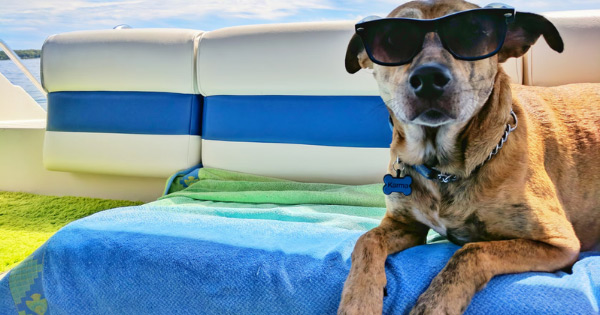
As we head into summer, you’re likely getting ready to head outdoors for some fun in the sun. But with summer comes a spike in temperatures, which can put your four-legged friend at risk of heatstroke. It’s important to know the common signs of heatstroke in pets so you can take preventative measures to ensure your pets stay cool and safe this summer.
What Does Heatstroke in Pets Look Like?
Heatstroke occurs when your pet’s body temperature rises above 100 degrees. Dogs and cats don’t respond to heat in the same way that we do, so it is important to help them manage it. They only have a few sweat glands on their feet and around their noses. Most pets rely on panting to control heat, as moisture evaporates from the oral cavity. If you notice excessive panting, ensure your pet has shade and fresh water available.
Certain breeds of dogs and cats are also much more susceptible to overheating. Flat-faced breeds such as bulldogs, and pugs, as well as Himalayan and Persian cats have a much more limited ability to cool off due to their shortened snouts. Heatstroke is a dangerous condition that can lead to organ failure, brain damage, and death if not treated immediately. It can also cause a chemical reaction that breaks down the cells in your pet’s body.
Ways to Prevent Heatstroke in Pets This Summer
Never Leave Your Pet in a Parked Car
You should never, ever leave your pet in a parked car, not even for a minute. Even with the air conditioner on or the windows partially rolled down, this is a dangerous situation. Heat rapidly builds up to dangerous levels on a warm day within the enclosed metal space. When it’s 80 degrees outside, the temperature inside a car can rise to 102 degrees in just 10 minutes and 120 degrees in 30 minutes. So, either leave your pets at home or ensure someone can wait with them in a shaded spot.
Take Care When Exercising Your Pet
Avoid exercising your pet during the hottest times of the day, which is typically between noon and 3 pm. Instead, adjust the intensity and duration of exercise according to the temperature. Consider taking your walks in the early morning or late evening hours, when temperatures are somewhat lower. Be especially careful with flat-faced, short-nosed pets who have difficulty cooling off through panting. Also, be careful of direct sun for pets with white ears due to their susceptibility to skin cancer. Avoid concrete, asphalt, and hot sand areas as they can burn your pet’s paws quickly. Additionally, be aware of the heat rising from the ground as this can overheat a low-slung pet. Always carry water with you when walking your pet to prevent dehydration.
Provide Water and Shade
When your pet is outside, ensure they have access to shade, fresh water, and shelter away from direct sunlight. In heat waves, add ice to their water for an extra cooling effect. Tarps and tree shades are ideal because they won’t obstruct airflow while providing shade. You could also consider investing in a wading pool for your pet to splash around in and cool off.
Keep Your Pet Cool
While you’re out running errands or visiting others, keep your pet inside your air-conditioned home. It’s best not to rely on a fan as they don’t cool off pets as effectively as they do people. You can also make quick and easy DIY popsicles and ice cream for your pet. For example, stuff a rubber Kong with your pet’s favorite treats like fresh berries, yogurt, tuna, or crunchy snacks. Simply toss the mixture in the freezer until solid, and your pet will have their own frozen treat to enjoy.
exercise and pets, You can also keep your pet from overheating with a cooling vest or body wrap. Simply soak the product in cool water and place it on your pet. The water will evaporate over time, taking excessive heat with it. Once it dries out you can rewet the vest and use it again.
Look Out for Signs of Heatstroke in Pets
Pets who have heatstroke are at risk for organ failure, brain swelling, and bleeding problems. Ultimately the best thing to do is to avoid having your furry friend outdoors when the temperatures are over 75-80 degrees. However, you should also keep a close eye on your pet for overheating signs, including:
- Excessive drooling
- Excessive panting
- Little to no urine production
- Vomiting
- Difficulty breathing
- Bright red or pale gums
- Dizziness, incoordination
- Agitation, restlessness
- Increased heart rate
- Muscle tremors
- Seizures
- Diarrhea, which may contain blood
- Lethargy, weakness
- Signs of mental confusion
- Sudden collapse
If your pet displays any of these signs, you need to act immediately as heatstroke can progress quickly. First, take your pet’s rectal temperature. If it’s above 102 degrees, cover your pet in towels soaked in water or wipe rubbing alcohol on their paws. Never place your pet in cold water as this can cause dangerous changes in blood pressure.
If your pet’s condition doesn’t improve within 10 minutes, contact Naples Coastal Animal Hospital immediately for advanced treatment. This may include blood pressure maintenance, intravenous fluids, or medication to combat heatstroke. At Naples Coastal Animal Hospital we also offer urgent and critical care services during daily business hours, so you can bring your pet in immediately for treatment.
